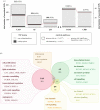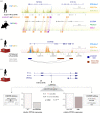The contribution of non-coding regulatory elements to cardiovascular disease
- PMID: 32603637
- PMCID: PMC7574544
- DOI: 10.1098/rsob.200088
The contribution of non-coding regulatory elements to cardiovascular disease
Abstract
Cardiovascular disease collectively accounts for a quarter of deaths worldwide. Genome-wide association studies across a range of cardiovascular traits and pathologies have highlighted the prevalence of common non-coding genetic variants within candidate loci. Here, we review genetic, epigenomic and molecular approaches to investigate the contribution of non-coding regulatory elements in cardiovascular biology. We then discuss recent insights on the emerging role of non-coding variation in predisposition to cardiovascular disease, with a focus on novel mechanistic examples from functional genomics studies. Lastly, we consider the clinical significance of these findings at present, and some of the current challenges facing the field.
Keywords: GWAS; cardiovascular; epigenetics; functional genomics; gene regulation.
Conflict of interest statement
We declare we have no competing interests.
Figures


References
Publication types
MeSH terms
Grants and funding
LinkOut - more resources
Full Text Sources
